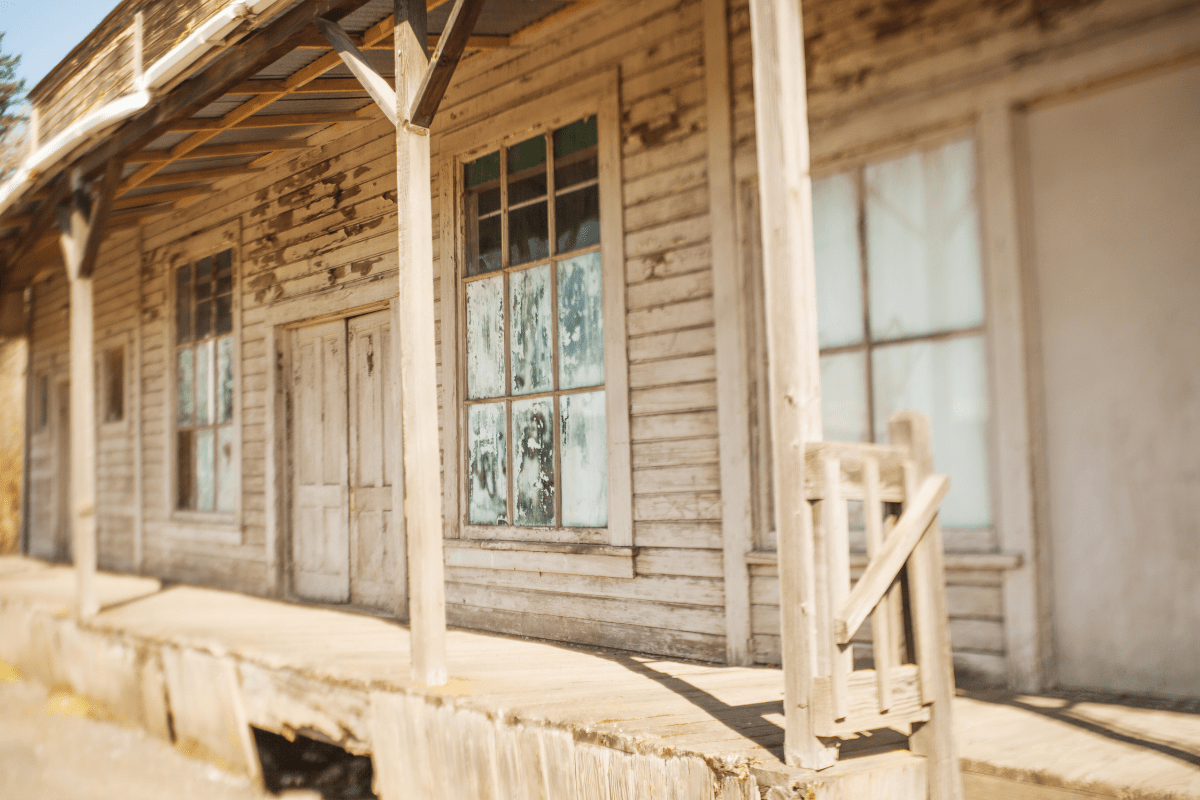Texas has more ghost towns than any other state, with over 500 abandoned settlements scattered across its vast landscape. These remnants of boom-and-bust dreams offer something you won't find in sanitized museums: the chance to literally walk through history, complete with creaky floorboards, desert-worn gravestones, and the occasional tumbleweed for dramatic effect.
Finding ghost towns you can actually visit
Here's the thing about Texas ghost towns… most of them sit on private property, and showing up uninvited is a great way to meet an unhappy rancher or, worse, get arrested for trespassing. The good news? Several spectacular ghost towns welcome visitors, and they're way more accessible than you'd expect.
Terlingua: Where ghosts share space with artists
Terlingua breaks every ghost town rule by refusing to stay dead. Located just 8 miles from Big Bend National Park's entrance, this former mercury mining boomtown somehow supports about 250 living residents alongside its photogenic ruins. During World War I, the Chisos Mining Company made this dusty outpost America's largest mercury producer, supporting 2,000 residents who probably never imagined their workplace would become Instagram famous.
The town's bankruptcy in 1942 should have been the end, but Terlingua had other plans. Artists and hermits started trickling in during the 1960s, drawn by cheap land and spectacular sunsets. Today, you can explore the Terlingua Cemetery with its 400+ graves while locals prepare for their annual Día de los Muertos celebration every November 2nd. The Perry Mansion, once home to the mine owner, now operates as luxury lodging that costs more per night than miners made in a month.
What really sets Terlingua apart is its working infrastructure nestled among the ruins. The Starlight Theatre serves upscale dinners in a converted 1931 movie house, complete with live music and craft cocktails. You can fuel up at Study Butte's gas station, grab supplies at the local store, and choose from accommodations ranging from the quirky Big Bend Holiday Hotel to desert glamping sites. Just remember that summer temperatures regularly exceed 115°F, making October through April your best bet for not melting into the desert floor.
Pro tip: The famous Terlingua International Chili Championship happens each November, transforming this quiet ghost town into Texas's wildest party. Book accommodations months in advance unless you enjoy sleeping in your car with several thousand chili enthusiasts.
Indianola: The town that nature erased twice
Indianola earns the award for "Most Dramatic Ghost Town Death," having been obliterated not once but twice by hurricanes. This former immigration port once rivaled Galveston, supporting over 5,000 residents and serving as the main entry point for German and Polish settlers heading into Texas. The 1875 hurricane killed up to 300 people and left only eight buildings standing. Apparently, that wasn't clear enough, so nature sent a Category 4 hurricane in 1886 with 155 mph winds, plus a fire for good measure.
Today, Indianola offers a uniquely haunting experience because much of the original townsite now lies underwater. Drive 15-20 miles southeast of Port Lavaca via Highway 316, and you'll find a 25-foot granite statue of French explorer La Salle standing guard over… basically nothing. At low tide, you can spot foundation remnants in Matagorda Bay's shallow waters, like archaeological ruins with a beach view.
The Indianola Cemetery contains weathered gravestones from the 1800s, including markers for Spanish camel handlers from the U.S. Army's bizarre camel experiment. Yes, the Army tried using camels in Texas. It went about as well as you'd expect. A fragment of the courthouse foundation bears an inscription about "precious lives saved within its walls" during the storms, which hits differently when you're standing where a town used to be.
Here's what makes Indianola practical for visitors: it offers free beach camping, one of the last such spots in Texas. The Indianola Fishing Marina provides the only services, including a restaurant that'll cook your catch for $12.99 and kayak rentals at $10 per hour. Just wear shoes on the shell-covered beach unless you enjoy impromptu foot acupuncture.
More accessible ghost towns worth your time
Glenrio straddles the Texas-New Mexico border at Interstate 40's Exit 0, making it ridiculously easy to find. This Route 66 casualty died instantly when I-40 bypassed it in 1973. The State Line Motel still advertises "First in Texas/Last in Texas," though nobody's checked in for decades. The bricked-up Little Juarez Café and art moderne Brownlee Texaco Station create perfect photography backdrops. Fun fact: different state laws once put gas stations on the Texas side (lower taxes) and bars on the New Mexico side (Texas was dry). That divide continues today… a cannabis dispensary opened on the New Mexico side in 2022.
Shafter, located 18 miles north of Presidio, produced 32 million ounces of silver between 1883 and 1942. About 11 to 30 people still live there, and the Sacred Heart Catholic Church holds Mass monthly. You can explore the headframe, mill ruins, and cemetery, but watch for open mine shafts that would really ruin your day. There are absolutely no services here, so bring everything from Presidio or Marfa, both over 40 miles away.
Medicine Mound in North Texas takes its name from four sacred hills that rise 200 feet above the plains, used for Comanche ceremonies. A 1932 fire destroyed downtown, leaving behind a "Population Zero" sign, the Hicks & Cobb General Store (now a museum), and rusty 1940s gas pumps that haven't dispensed anything in decades.
Planning your ghost town adventure
Let me save you from learning these lessons the hard way.
What to bring (seriously, bring these)
Water tops the list, and I mean actual water, not just that half-empty Dasani rolling around your backseat. Plan on one gallon per person per day minimum. Many of these towns were abandoned precisely because water sources failed, so don't expect to find any.
Your phone will become an expensive camera in most locations. Cell coverage is essentially non-existent once you leave major highways. Download offline maps before you go, bring a physical map as backup, and consider a satellite communicator if you're heading somewhere truly remote. Getting stranded with a dead car battery 50 miles from nowhere isn't an adventure… it's a survival situation.
Vehicle considerations that actually matter
You can reach Terlingua, Glenrio, and Helena in your trusty Honda Civic. But if you're dreaming of finding untouched ruins in the Big Bend backcountry, you'll need high-clearance 4WD. Many access roads become impassable mud pits after rain, turning your ghost town expedition into an expensive tow truck bill.
RV travelers, heads up: anything over 24 feet won't make it through Chisos Basin roads. Gas stations in West Texas are about as common as vegetarian options at a BBQ joint. Marathon and Van Horn serve as critical fuel stops with 200+ miles between stations in some areas. That gauge showing a quarter tank? Fill up now.
Safety stuff that sounds paranoid until it isn't
Abandoned mine shafts pose the greatest danger in ghost towns. They're often unmarked, hidden by brush, and deep enough that nobody will hear you scream. Never, and I mean never, enter old mine workings. That Instagram shot isn't worth becoming a permanent resident.
Five additional safety considerations:
- Rattlesnakes love abandoned buildings
- Roofs collapse without warning
- Flash floods hit desert washes fast
- Old wells hide under vegetation
- Rusty nails exist everywhere
If you're exploring alone (not recommended but I get it), leave detailed plans with someone reliable. Set check-in times. Tell them exactly where you're going and when you'll be back. "Exploring some ghost towns in West Texas" isn't a plan… it's a missing person report waiting to happen.
The legal and ethical stuff you need to know
Understanding Texas trespassing laws
Texas doesn't mess around with trespassing. It's a Class B misdemeanor punishable by up to 180 days in jail and $2,000 fines. Many ghost towns require landowner permission to visit. Research ownership through county records and always respect "No Trespassing" signs. That romantic notion of stumbling upon an undiscovered ghost town? It's usually called "criminal trespassing."
The Texas Antiquities Code prohibits removing artifacts over 100 years old from public lands. Professional permits are required for any archaeological collection. Even on private property with permission, ethical visitors leave artifacts undisturbed. That rusty horseshoe or old bottle might seem worthless, but it's part of the site's story.
Following the ghost town code
The ghost town community follows an unwritten but widely respected code: "Take only pictures, leave only footprints." This means no rearranging objects for better photos, no entering dangerous structures for unique angles, and definitely no souvenir collecting.
Cemetery etiquette matters even more. These aren't photo props… they're final resting places. Don't run, keep voices respectful, and never disturb grave decorations. During Terlingua's Día de los Muertos celebrations, families leave offerings for deceased miners. Respect these tributes like you'd want someone to respect your grandmother's grave.
Understanding why Texas has so many ghost towns
Texas leads the nation with 511 completely abandoned towns, and nearly 1,000 communities have appeared and disappeared from state maps over time. The Texas Historical Commission identifies railroad bypasses as the leading cause of abandonment. Towns like Helena thrived as county seats until the railroads chose alternate routes in the 1880s, turning bustling communities into memories overnight.
The pattern continues today. A recent study found 75 Texas counties lost population from 2022 to 2023. Rural hospital closures and school consolidations accelerate the decline. As historian T. Lindsay Baker wrote in "Ghost Towns of Texas," these communities die from "economic changes beyond" the control of the people who live there.
Natural disasters created some of Texas's most dramatic ghost towns. Indianola's double hurricane destruction remains the most famous, but floods, droughts, and tornadoes all contributed to the ghost town map. Mining towns died when ore ran out. Oil boomtowns busted when wells went dry. Agricultural communities withered during the Dust Bowl.
Preservation efforts and how to help
The Texas Preservation Trust Fund awards grants from $10,000 to $50,000 for restoration projects. They received 48 applications requesting nearly $1.9 million for 2026 alone, showing how many sites need help. The Washington-on-the-Brazos reconstruction cost $51 million, demonstrating what's possible with adequate funding.
Most ghost towns lack such resources. They sit on private property without legal protection, exposed to weather, vandalism, and natural deterioration. The Historic Courthouse Preservation Program has completed 74 full restorations since 1999, but hundreds more structures crumble each year.
You can help preserve these sites through simple actions. Support local businesses near ghost towns. Join organizations like Preservation Texas or the Texas Historical Foundation. Report vandalism to authorities. Follow Leave No Trace principles. Even sharing accurate information about these sites helps counter the treasure hunter mentality that leads to destruction.
Making the most of your ghost town visits
The best time to explore Texas ghost towns runs from October through April, when temperatures won't cook you like BBQ brisket. Spring wildflowers add color to your photos, while winter's stark light emphasizes the abandonment aesthetic. Summer works only if you enjoy suffering or have extraordinary heat tolerance.
Start with easily accessible sites like Terlingua or Glenrio to gauge your interest. These towns offer the ghost town experience with backup plans if things go wrong. Once you're comfortable, venture to more remote locations. Join online forums and Facebook groups where ghost town enthusiasts share current conditions, access information, and GPS coordinates for harder-to-find sites.
Remember that these aren't just Instagram backdrops or adventure playgrounds. They're three-dimensional history lessons about human ambition, economic forces, and the relentless march of time. Every collapsed building housed dreams. Every cemetery holds stories. Every rusted artifact served a purpose in someone's daily life.
Texas ghost towns reward the curious, the respectful, and the prepared. They offer experiences you won't find in conventional tourist destinations… the chance to stand where communities thrived and failed, to photograph subjects that won't exist much longer, and to connect with a grittier, more authentic version of Texas history. Whether you're drawn by historical interest, photographic opportunities, or simple curiosity about places time forgot, these abandoned settlements deliver experiences that justify the long drives, the careful planning, and yes, even the occasional tumbleweed to the face.





